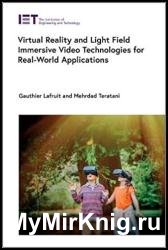 Название: Virtual Reality and Light Field Immersive Video Technologies for Real-World Applications Название: Virtual Reality and Light Field Immersive Video Technologies for Real-World Applications
Автор: Gauthier Lafruit, Mehrdad Teratani
Издательство: The Institution of Engineering and Technology
Серия: IET Computing
Год: 2022
Страниц: 390
Язык: английский
Формат: pdf (true)
Размер: 33.73 MB
Virtual reality (VR) refers to technologies that use headsets to generate realistic images, sounds and other sensations that replicate a real-world environment or create an imaginary setting. VR also simulates a user's physical presence in this environment. In virtual reality, six degrees of freedom allows users to not only look around, but also to move around the virtual world and look from above, below or behind objects. To have a true VR experience, the hardware must provide six degrees of freedom, using both orientation tracking (rotational) and positional tracking (translation).
This book is addressed to video experts who want to understand the basics of 3D representations and multi-camera video processing to target new immersive media applications. Unlike single camera video coding, future VR technologies address new challenges that arise beyond compression-only, including the pre- and post-processing (depth acquisition and 3D rendering). This book is inspired by the MPEG-I (immersive media) and JPEG-PLENO (plenoptic media) standardization activities, and offers a glimpse of their underlying technologies.
OpenGL is one of the most famous 3D technologies. GL stands for Graphics Library, and Open indicates it is open source and completely royalty free: whoever uses OpenGL drivers on a PC does not have to pay a penny to anyone for using it. Historically, OpenGL was developed in the 1990s, then taken over by the Khronos Group, a standardization committee for open standards in 3D, and has since then gradually evolved to a very mature 3D software framework. It has all the necessary APIs and drivers to work smoothly with all graphics processing units (GPUs) that nowadays reach outstanding performances, supporting real-time 3D applications, from video gaming to VR.
A typical VR application will have a 3D model of the scene that has to be rendered to both eyes of the user wearing the VR headset. The position of the headset is continuously tracked with internal accelerometers and/or external tracking devices (a), and with this position in mind, the OpenGL application (b) computes from the 3D model (c) what the user would see (d) for his/her specific head position, when staring at the virtual 3D scene. A pair of stereoscopic images are calculated in a blink of an eye, and projected in the headset, immersing the user into the virtual world.
Contents:
1 Immersive video introduction
2 Virtual reality
3 3D gaming and VR
3.1 OpenGL in VR
3.2 3D data representations
3.3 OpenGL pipeline
4 Camera and projection models
4.1 Mathematical preliminaries
4.2 The pinhole camera model
5 Light equations
6 Kinematics
7 Raytracing
8 2D transforms for VR with natural content
9 3DoF VR with natural content
10 VR goggles
11 6DoF navigation
12 Towards 6DoF with image-based rendering
13 Multi-camera acquisition systems
14 3D light field displays
15 Visual media compression
16 Conclusion and future perspectives
Index
Скачать Virtual Reality and Light Field Immersive Video Technologies for Real-World Applications
|